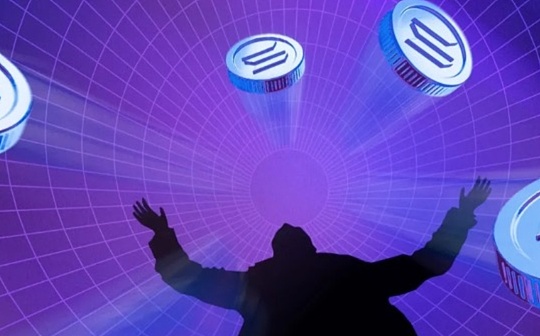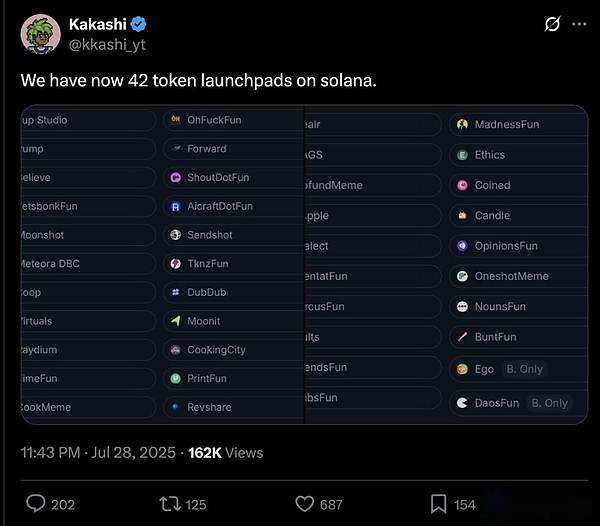
Author: Squid | drift, source: X, @airtightfish, compiled by Saoirse
There are dozens of homogeneous Launchpads on Solana, and they are still adding new products every day.

This article aims to provide a simple framework that helps sort out the chaos in the industry and triggers thinking.Let’s start from the core issues:
Why would users choose the new Launchpad instead of Pump.Fun (or Bonk today)?
Users can be divided into two categories: bidders and deployers.Although these two groups are highly correlated, since funds are scarce resources, bidders are the core group we focus on first.
To analyze why buyers choose new platforms over top platforms, the answer is simple: they think there are more opportunities for making money on the new platforms.But many of these factors are beyond the control of the platform, so this article focuses on two major drivers that the platform can control:
-
Assets:Can the platform create assets with significant differentiated value?
-
Flows: Does the platform have a differentiated deployer process?
Let’s dive into it in depth.
Assets
There are two main reasons why people buy tokens: one is speculation (thinking that tokens will appreciate), and the other is practical (the tokens have practical uses).
-
Speculation level: There are many driving factors for speculation, mainly including memes (such as Meme coins) and fundamentals (such as the value brought by capital reserves, cash flow, etc.).
But Launchpad cannot differentiate at the speculative level.Memes are spontaneous and rely on the market, while fundamental factors such as returns are ultimately determined by the project party or product.
-
Practical level: Practicality is more flexible, which means “besides speculation, why do people buy tokens?” (Of course, practicality is closely related to speculation, because practicality can drive speculation).For example, token access rights, handling fee discounts, governance rights, etc. are all practical.
Launchpad can provide practical advantages by providing differentiated supporting infrastructure and tools., allowing deployers to access from the first day of online launch.This type of support is diverse, but competition may focus on platforms that are more focused on vertical areas.It should be noted thatSupporting facilities should not only give tokens unique utility, but also create “valued utility”, that is, give the user a reason to purchase.
Social Token Case: Ego vs Time.Fun
Both attempt to tokenize social influence, and each creator can only issue one “soul-bound token” bound to a Twitter account.
-
Although Ego’s tokens are owned by the creator, they lack direct use.This “flexibility” leads to a lack of motivation for creators to build utility, ultimately leaving their tokens with no essential difference from the tokens on the Pump platform.
-
Time.Fun is different.It has built-in practical features for tokens, allowing creators to quickly create value and make profits through tokens, thus achieving continuous user activity.
(It is necessary to note: I agree with the Ego team and chose this case because I believe they will continue to optimize.)
In addition, “providing utility” does not mean “creating value”.For example, many tokenized platforms based on tweets integrate tweets into supporting facilities to form “value-based selected social communication.”Although this is a utility, if no one uses the social communication, its value will be zero.Such platforms often have difficulty creating real value.
It is worth noting that creating value is not easy, and it is necessary to carefully evaluate whether the supporting facilities or design is truly valuable.At the same time, differentiation is relative.Although the current popular functions of the industry such as “token repurchase tool” and “project economy and token flywheel binding” are valuable in the short term, they will soon become standardized technology.Once differentiation is lost, it is no longer attractive.
To sum up,When evaluating a new platform from the perspective of “assets”, you need to think about: Where does the differentiation of tokens be reflected?Does this differentiation add value to the token?
The areas I currently focus on include: incentive distributed training, next-generation decision-making market (there are some interesting mechanisms), niche real-world assets (there are some novel designs), initial token issuance mechanism (ICM, in the early stage and with great potential).
Flows
Next, we will discuss another differentiator: exclusive deployer “traffic”.This is similar to the “trading flow” of venture capital,The core is whether the platform can attract the most popular projects to be launched.
From the perspective of limited partners (LP), one of the keys to evaluating venture capital institutions is whether they have high-quality exclusive transaction flows.This logic also applies to Launchpad.The return structure of the two is similar (the top projects contribute most of the transaction volume/revenue), and the essence is “let the value-creating person choose you over homogeneous competitors.”
For example, a reverse view holds that Believe’s early success did not stem from mechanism design (in fact, I don’t agree with this design), but because its founder Pasternak was able to attract Web2 entrepreneurs who would not issue tokens—this is the value of traffic.
Large platforms are born with traffic advantages: they have users, ecological integration capabilities and distribution channels.But user attention is a scarce resource, and new platforms must rely on practical differentiation to attract traffic.
The following isSeveral common factors in traffic differentiation:
-
Founder influence: The crypto industry has a small circle and connections are crucial.Do the founders of the platform have enough social resources to attract deployers?Can we win social support for the tokens after the project is launched?(e.g. Pasternak)
-
Development momentum: Is there any successful online case of the platform?For example, Bonk’s Launchpad has inspired more people to issue and bid for tokens on it, forming a “social flywheel effect”.Early platforms should screen high-quality projects to provide in-depth support. A few failed launches may destroy a platform. After all, the flywheel effect is two-way.
-
Professional positioning: If the platform focuses on a certain sub-sector, it can increase project exposure.For example, in the fields of AI proxy and virtual assets (although the tokens themselves are homogenized), especially when the platform is aimed at non-crypto-native users, the advantages of specialization are more obvious.
-
Capital formation capability: For projects that tend to be more commercially-oriented, financing capabilities in the early stages of launch may affect the final success or failure.Does the platform’s issuance mechanism and coverage help to form a higher level of capital?
-
Practicality: As mentioned above, the practicality of assets can directly attract traffic.
To sum up,When evaluating a new platform from the perspective of “traffic”, you need to think about: Why did the deployer choose this platform?What is the reason for their current choice?Is this differentiation sticky and scalable?
Market Perspective
The following is my analysis of the direction of mainstream Launchpad in the market(Not marked chain on Solana):
-
BonkFun: Industry leader, meme advantages are significant.Its leading position is more stable than imagined, and it will be difficult to shake unless a brand new incentive mechanism platform appears.
-
Raydium, Jup, Orca (to be launched): Assets are not differentiated, technology has been standardized, but traffic can still be maintained with the advantages of brand and capital.The focus of competition is business development. Whoever can attract more platform cooperation will better support popular tokens.
-
Pump.fun: There is a lack of differentiation before launching more streaming features and traffic is losing.Unless incentives are initiated or new products are released, it is difficult to get back to the peak in the short term.Radical acquisitions or funding operations may become variables.
-
Block: Due to its cooperation with WLFI, it has differentiation at the asset level.
-
Zora:(Deployed on the Base chain)Relying on the Base ecosystem, traffic has become the leading platform, but due to asset homogeneity, its market share may decline as more platforms enter (but the support of the Base camp may reverse this trend).
-
Doppler: As “Launchpad of Launchpad”, it has high industry recognition and good development prospects.
-
MetaDAO: Asset creation is differentiated, but the value of the governance mechanism needs to be proved.
-
Vertigo: Assets are not differentiated (counter-sniper technology has been standardized), but there is still a chance to attract deployers.
-
Believe:(Deployed in BNB Smart Chain)The core advantage lies in traffic, but the current deployment is lost and the market sentiment is unclear.I still have expectations for this project and need to evaluate its health through the newly launched project.
-
heaven:(Deployed in BNB Smart Chain)The core issue with excellent design is how to attract high-quality deployers, and their investors may be able to provide support.
-
The Metagame(Deployed in BNB Smart Chain), Trends: The details are unknown, but the team is a veteran crypto native player (this is crucial) and is expected to break through in the social field.
Summarize
-
Verticalization is an important opportunity, but it must create real value.
-
Early layouts are more likely to earn returns than betting on “defensive” or market growth.
-
Novelty should be valued.







